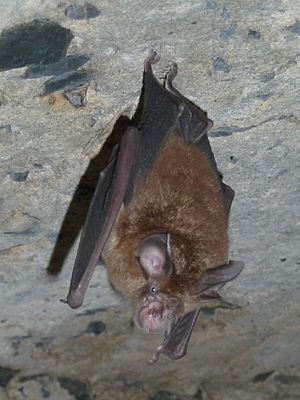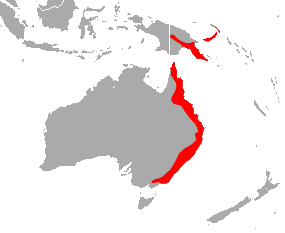Smaller horseshoe bat facts for kids
Quick facts for kids Smaller horseshoe bat |
|
|---|---|
 |
|
| Conservation status | |
| Scientific classification | |
| Genus: |
Rhinolophus
|
| Species: |
megaphyllus
|
 |
|
| Smaller horseshoe bat range | |
The smaller horseshoe bat (Rhinolophus megaphyllus) is a type of bat that lives in Australia and Papua New Guinea. It belongs to a family of bats called Rhinolophidae. These bats are special because of their unique nose shape, which looks a bit like a horseshoe!
Contents
About the Smaller Horseshoe Bat
Scientists give every animal a special scientific name. The smaller horseshoe bat was first described by a scientist named John Edward Gray in 1834. He studied a bat found in a cave near the Murrumbidgee River.
This bat is also known by another common name: the eastern horseshoe bat.
What Does It Look Like?
The smaller horseshoe bat is a small bat. Its head and body together are about 44 to 53 millimetres long. That's about the length of your thumb! Its forearm, which is part of its wing, is about the same length. These bats weigh between 7 and 13 grams, which is about as light as a few paperclips.
They have large, simple ears that are 12 to 21 millimetres long. Their eyes are very tiny. The most interesting part of their face is their nose-leaf. This is a special fleshy shape on their snout.
The fur on their back is usually a dark grey-brown color. Their belly is a lighter shade. Some bats in Queensland, Australia, can even have reddish-orange fur!
The Horseshoe Nose
All bats in the Rhinolophus group have a special nose-leaf. It's shaped like a horseshoe and helps them use echolocation. This means they send out sounds and listen for the echoes to find things in the dark.
The smaller horseshoe bat has a pink nose-leaf. It has ridges on the top part that form a triangular point. There's also another structure in the middle of the leaf. The pink nose-leaf has grey edges and a fairly simple shape.
How It's Different from Other Bats
Another bat, the large-eared horseshoe bat (Rhinolophus philippinensis), lives in the same area. You can tell them apart because the large-eared bat has ears longer than 25 millimetres. It also has bigger wings and a more complex nose-leaf.
The sounds these bats make are also different. This helps scientists tell them apart.
How They Live
Smaller horseshoe bats fly with a fluttery motion. Their wing shape lets them fly slowly and turn easily. This helps them hunt for insects in the forest. They often catch insects while flying.
They mostly eat Lepidoptera (like moths) and Coeloptera (like beetles). Their diet can change depending on what insects are available.
Instead of clinging to walls, these bats hang from the ceiling of caves. They usually roost a little bit apart from each other. Sometimes, they wrap their wings around their bodies like a cloak.
Where They Live
The smaller horseshoe bat lives in eastern Australia and New Guinea. They can be found in places up to 1600 metres asl high.
In eastern Australia, they are common in suitable areas. Their range stretches from the tropical Cape York Peninsula down the east coast to the Great Dividing Range. They can even be found as far south as the cooler climate of Victoria.
During the 1900s, these bats started living in old, abandoned mine tunnels in Victoria. They need warm, humid places like caves or old mines to rest during the day and raise their young.
Sometimes, large groups of up to two thousand bats can live together. But usually, a colony has between five and fifty bats. They use special maternity sites (places just for mothers and babies) starting in September or October. The young bats are born and grow there. Then, in March or April, they leave to join the males for mating.
Conservation Status
The IUCN has looked at the smaller horseshoe bat. They have listed its conservation status as "least concern." This means that the bat is not currently in danger of disappearing.
They live in protected areas and old mine shafts. Scientists haven't seen a big drop in their numbers. However, we don't know exactly how their population is changing over time.
See also
 In Spanish: Rhinolophus megaphyllus para niños
In Spanish: Rhinolophus megaphyllus para niños


